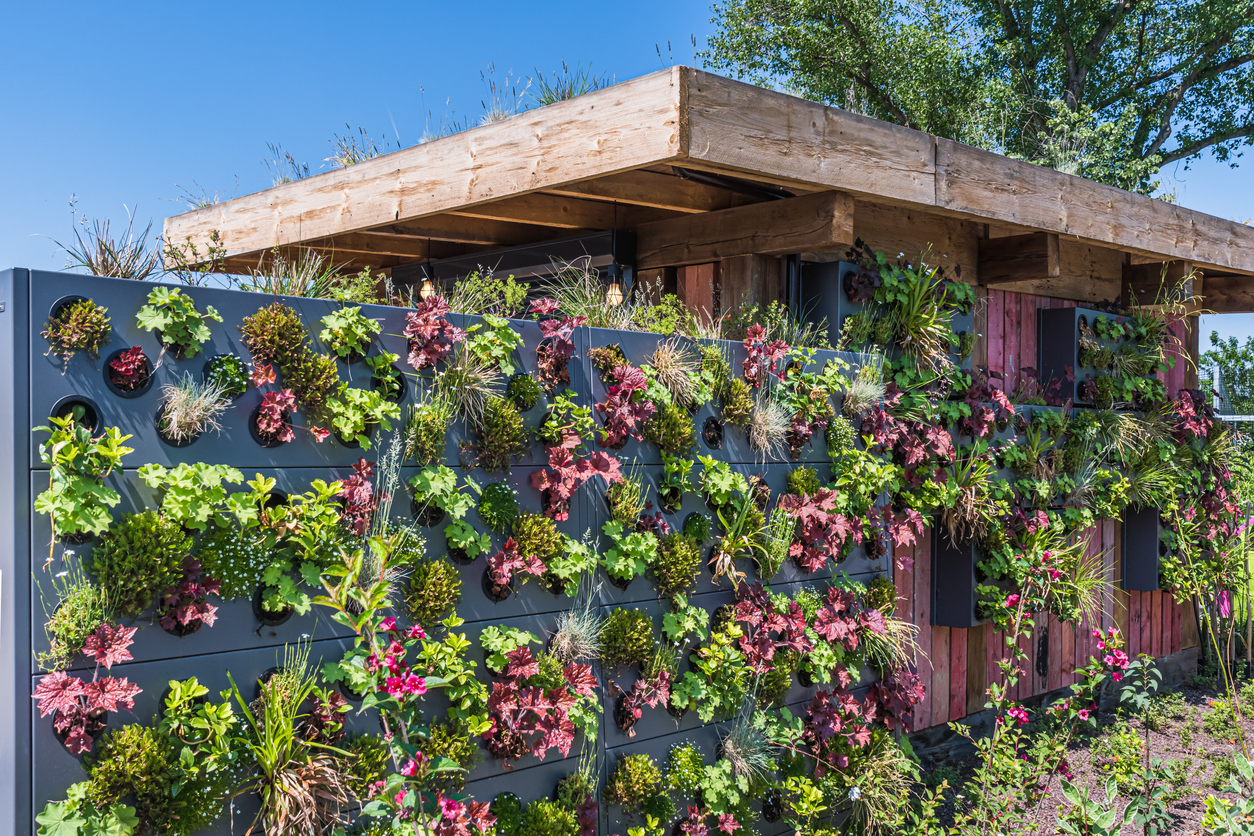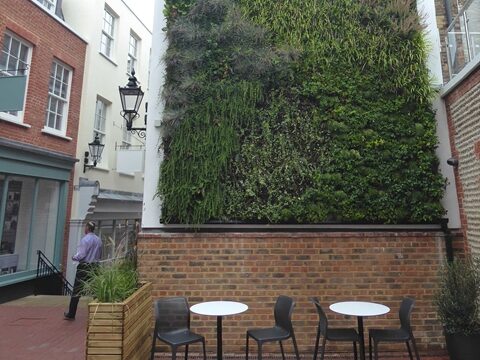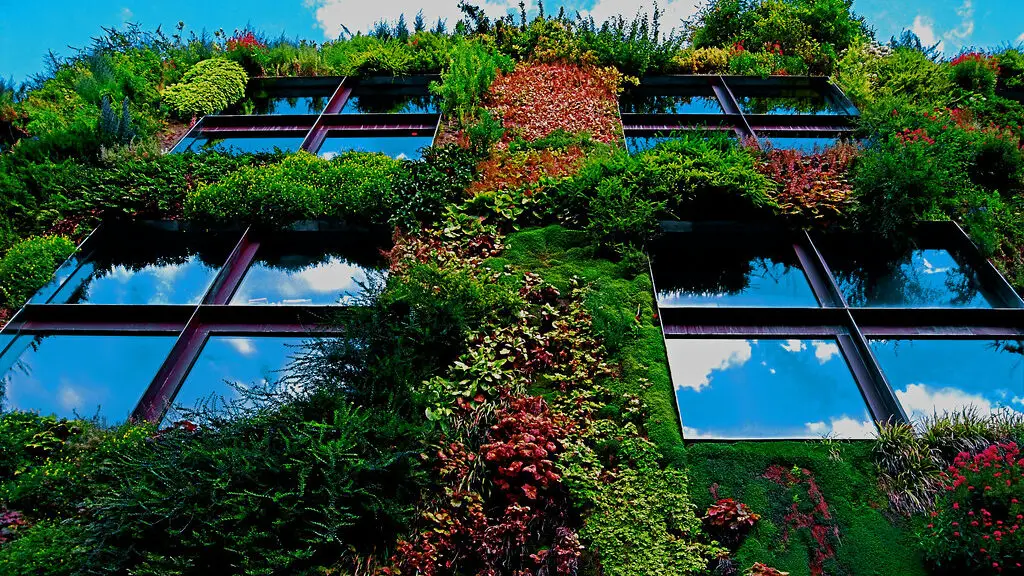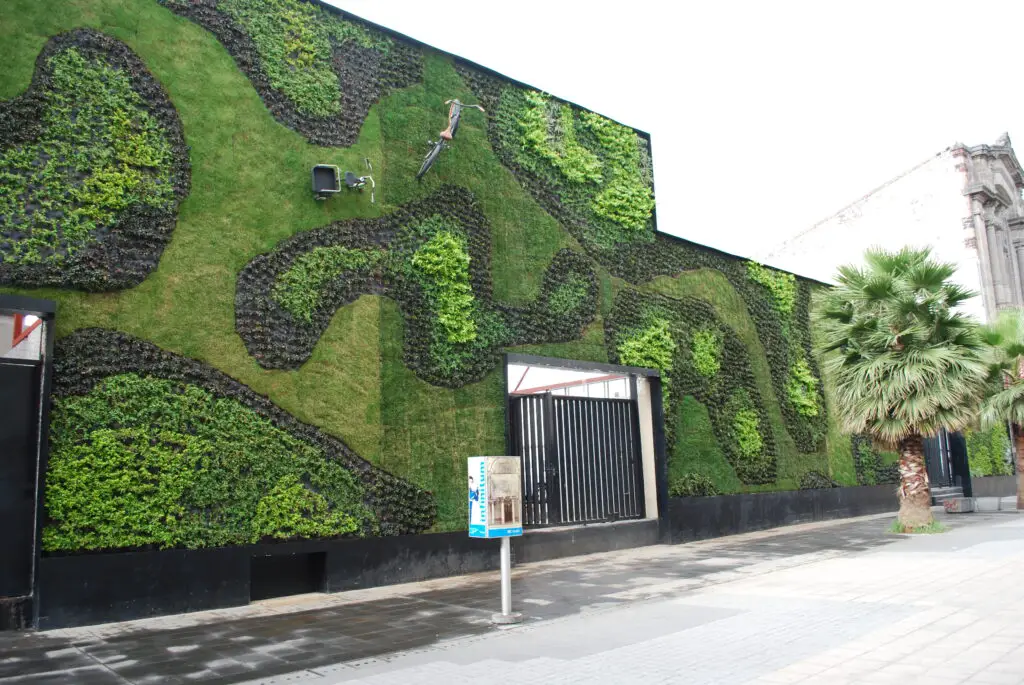As traditional fences are gradually being replaced by more innovative and sustainable solutions, homeowners are increasingly turning to living walls as a stylish and functional alternative. These vertical gardens, which consist of plants growing directly on the wall, offer a multitude of benefits, from enhancing privacy to improving air quality. Not only do living walls add a fresh, natural element to properties, but they also serve as eco-friendly solutions in urban settings where space is limited. In this article, we explore 12 examples of how homeowners are embracing living walls to transform their outdoor and indoor spaces while reaping the environmental, aesthetic, and practical benefits of this growing trend.
1. Eco-Friendly Design

Living walls are growing in popularity as eco-conscious homeowners move away from traditional fences and opt for more sustainable alternatives. A living wall is essentially a vertical garden, where plants grow directly on the surface of a wall. Biotecture says that these green walls offer several environmental benefits, including the ability to reduce urban heat, improve air quality, and increase biodiversity. By replacing fences with living walls, homeowners can create natural habitats for birds and insects while simultaneously reducing their carbon footprint.
Living walls also help manage rainwater and reduce runoff, as plants can absorb and filter rainwater. This makes them an excellent choice for those living in areas prone to flooding or water management issues. With their natural ability to combat air pollution and improve the overall aesthetic of a property, living walls are not only a trend but also a way to contribute to a more sustainable, green future.
2. Privacy Without the Need for Fences

One of the most significant advantages of living walls is their ability to provide privacy without the use of traditional fences. Unlike regular fences, which can sometimes feel impersonal and stark, living walls offer a more organic and visually appealing way to create boundaries between properties. HGTV says that with carefully chosen plants, a living wall can grow thick and lush, providing a natural barrier that shields your space from the view of neighbors and passersby.
Moreover, living walls can be tailored to suit your privacy needs. Homeowners can choose from a variety of plant species that offer dense foliage or grow tall and thick to block out sightlines. For those looking for a bit of versatility, living walls can also be adjusted throughout the year as the plants change, providing privacy even during winter months when some fences may lose their functionality.
3. Aesthetic Appeal and Customization

Living walls offer unparalleled aesthetic benefits compared to traditional fences, notes The Spruce. Instead of a simple wooden or metal barrier, homeowners can cultivate a dynamic and ever-changing landscape. Whether you choose vibrant flowers, climbing vines, or low-maintenance succulents, a living wall can become a beautiful focal point that adds texture and color to your outdoor space. This flexibility allows homeowners to showcase their creativity and personalize their outdoor areas with lush, natural beauty.
Additionally, living walls can be customized to reflect a homeowner’s tastes and the surrounding environment. From cascading ivy to tropical plants, the possibilities are virtually endless. For urban homeowners who may not have a lot of space for traditional gardens, a living wall offers a creative solution to bring greenery into their lives, making even the smallest of outdoor spaces feel like an oasis.
4. Environmental Benefits

The environmental advantages of living walls are substantial, says Science Direct. Traditional fences, especially those made from wood or synthetic materials, often have a significant carbon footprint, contributing to deforestation or manufacturing waste. In contrast, living walls use plants that absorb carbon dioxide and release oxygen, helping to improve air quality. They can also help reduce the urban heat island effect by providing natural shade, which can cool down surrounding areas and reduce the need for air conditioning.
Beyond just cooling the air, living walls also help to combat pollution by filtering harmful particles and toxins from the environment. Plants act as natural air purifiers, and their ability to trap pollutants helps to improve the air quality around your home. In a world where cities are becoming more congested and polluted, living walls offer a breath of fresh air—literally.
5. Noise Reduction

Another surprising benefit of living walls is their ability to reduce noise pollution. Traditional fences may offer a modest barrier to sound, but living walls are far more effective in creating a quiet environment. The plants in a living wall absorb, deflect, and break up sound waves, making them an excellent option for homes located near busy streets, highways, or other noisy environments.
Not only does this make your outdoor space more serene, but it can also enhance your indoor living experience. By reducing the amount of noise that enters your home, living walls can help create a more peaceful atmosphere, allowing for better relaxation and focus within the home.
6. Low Maintenance Option

Although they may initially seem like a high-maintenance alternative to traditional fences, living walls can actually be quite low maintenance once established. Many plants used for living walls, such as succulents or drought-resistant varieties, require little care beyond occasional watering and pruning. In fact, some living wall systems are designed to be self-sustaining, with automated irrigation systems that take the guesswork out of maintaining the plants.
Additionally, living walls are adaptable to a variety of climates. In areas with more extreme temperatures or dry conditions, homeowners can select hardy plants that will thrive without excessive watering or upkeep. This makes living walls a practical and sustainable choice for those who want to enjoy a beautiful, green space without investing too much time and effort.
7. Boosting Property Value

Investing in a living wall can increase your property’s value. As the trend of vertical gardens and green spaces continues to rise in popularity, homeowners are finding that a lush, well-maintained living wall can be a selling point for potential buyers. The aesthetic appeal, environmental benefits, and privacy features of a living wall can make your property stand out in a competitive market.
Beyond just the visual appeal, living walls also add functional value by improving air quality, reducing noise pollution, and creating private outdoor spaces. In urban areas where green spaces are limited, a living wall can be a desirable feature that sets your property apart.
8. Edible Gardens as Living Walls

For those looking to combine functionality with beauty, edible gardens are a growing trend in living walls. Homeowners are increasingly opting for vertical gardens that feature herbs, vegetables, or even fruit-bearing plants. This trend allows individuals to cultivate their own food right at home, all while maintaining an aesthetically pleasing green space.
Edible living walls can provide a steady supply of fresh, homegrown ingredients for cooking, which adds both convenience and sustainability to daily life. Plus, growing your own food reduces reliance on store-bought produce, which can have a high environmental cost in terms of packaging and transportation.
9. Improving Mental Health and Wellbeing

Having a living wall in your yard can significantly improve your mental health and well-being. Studies show that exposure to nature can reduce stress, improve mood, and even boost cognitive function. A living wall provides a natural, calming environment where you can unwind and connect with nature.
The act of tending to plants can also promote mindfulness and a sense of accomplishment. Creating a beautiful outdoor space with living walls offers an opportunity to enjoy the therapeutic benefits of gardening without the need for extensive yard space. Whether you’re relaxing in your garden or simply enjoying the view, the presence of a living wall can elevate your outdoor experience.
10. Modern and Urban Appeal

Living walls are particularly appealing in modern, urban environments where space is limited, and green areas are often scarce. For homeowners in cities or metropolitan areas, a living wall provides an opportunity to incorporate nature into their living spaces without taking up valuable ground area. These vertical gardens can be installed on rooftops, balconies, or even on the sides of buildings, making them an ideal solution for urban dwellers seeking a touch of greenery.
In addition to their environmental benefits, living walls help to modernize the exterior of a property, lending it a sleek, contemporary look. For homeowners looking to add a touch of modernity to their homes, living walls offer an easy way to achieve a cutting-edge design while keeping the environment in mind.
11. Alternative to Traditional Landscaping

For those who want a unique and low-maintenance alternative to traditional landscaping, living walls are an ideal option. Instead of spending hours mowing the lawn, trimming hedges, or planting and weeding flower beds, homeowners can focus on maintaining a living wall, which requires minimal upkeep. The vertical nature of these gardens also reduces the amount of space needed, making them perfect for small yards or properties with limited space for landscaping.
Living walls also offer the opportunity to experiment with a variety of plant species and layouts. Whether you prefer a minimalist design or a more tropical, jungle-like aesthetic, you can customize your living wall to reflect your personal style while keeping the overall maintenance low.
12. Indoor Living Walls

The trend of living walls isn’t just confined to outdoor spaces—many homeowners are also bringing the concept indoors. Indoor living walls can add a vibrant, natural element to a home’s interior, whether in the form of a statement piece in the living room or as a way to green up smaller spaces like kitchens or bathrooms.
Indoor living walls not only improve air quality but also create a refreshing, peaceful environment. With the right plants, an indoor living wall can serve as a striking focal point in a room while also providing health benefits like improved air purification and humidity regulation.
